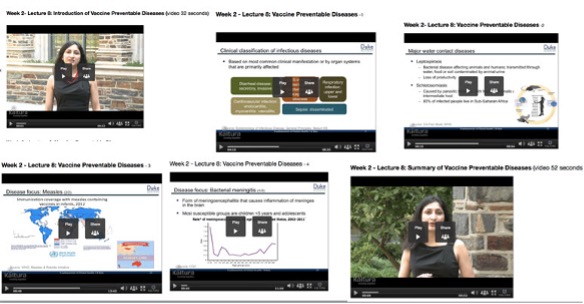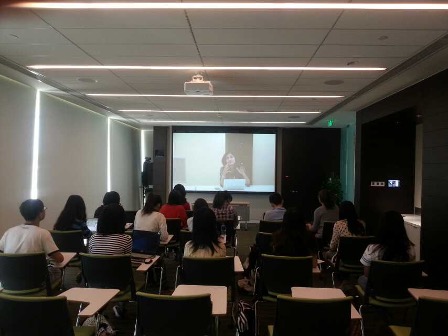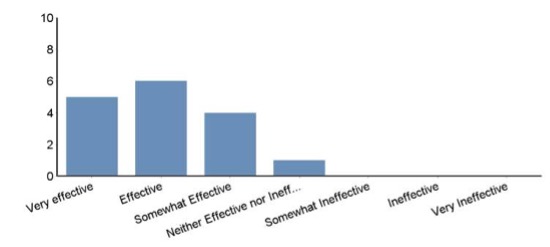By Haiyan Zhou
Dr. Rukmini Balu is one of the faculty members who taught Duke Kunshan University (DKU) inaugural classes in Fall 2014. She taught “Fundamentals of Global Health” course for the undergraduate “Semester Abroad” or “Semester Away” students. The seven-week intensive course was offered in an innovative way to incorporate face-to-face learning with technology-driven, remote learning methods. The course was designed to closely mimic a full-semester course offered at Duke in Durham, but featured a new format that blended online and on-site activity between campuses.
At that time, former Duke provost Peter Lange and the Advisory Committee for Online Education (ACOE) were seeking proposals for online education projects, such as Dr. Balu’s course, as a starting point to generate ideas.
Why blended learning format?
When Dr. Michael Merson, Director of the Duke Global Health Institute (DGHI), initially asked Prof. Balu to consider teaching at DKU, she thought it was a great idea. However, Prof. Balu’s full time job as Director of Strategy and Partnership Development for Duke Medicine Global and a mom of two young children, would prevent her from staying all 7 weeks at DKU. After further consideration, Dr. Merson suggested designing a blended learning format.
While planning to allow flexibility in location and time, especially with the 12-hour time difference between China and Durham, Prof. Balu still wanted to design a rich experience for students. In addition to lectures, she incorporated guest speakers, team projects, student-centered discussions, field trips, and case studies into the course, as the result of redesigning the engaging learning activities.
Portfolio of the blended format

Table: Portfolio of learning methodologies
As early as January 2014, Prof. Balu started to work closely with the Center for Instructional Technology (the former Duke Learning Innovation) to plan the course redesign, determine what technologies were possible to use and would fit, and put together materials that would be delivered via this broad format. In Fall 2014, she taught Week 1 and Week 7 of the course on-site at DKU.
During these two weeks, she was able to meet students in class four days each week and work with students one-on-one during her office hours. Additionally, she and Prof. David Boyd, a guest speaker, took students on field trips to local hospitals.
From Week 2 to Week 6, while she was in Durham, she continued to interact with her students through synchronous teleconferencing. However, she didn’t offer the teleconferencing sessions four or five times per week like in a face-to-face class, instead, she reduced meetings to two sessions per week, and let students watch pre-recorded short lecture videos at their own pace. At the same time, students will follow the prescribed timelines for group work, online forums and other activities. During the teleconferencing meetings, she focused on discussing the content covered in the video, answering questions, addressing problem areas, and paying attention to specific areas of understanding. This flipped “tele-classroom” offered flexibility for students and the instructor, and was beneficial to those who were not equally fluent in, or comfortable with, English. Out of the 22 enrolled students in the course, about 90% did not speak English as their native language.
Technologies used
Lecture video in Kaltura: During summer 2014, Prof. Balu spent hours and hours recording over 40 videos using a recording kit given by the Duke Online Initiatives. Each video was less than 10 minutes long, and was uploaded to Kaltura for streaming. In order to give students a sense of being at Duke University’s campus, she had an additional 20 videos shot and edited by professionals from the Duke Media Services (DMS). These videos were set at typical Duke scenes, such as the Duke Chapel, Duke Gardens, Trent Semans Medical Center, etc.

Sakai, Learning Management System: Students used Sakai as a learning platform to access lessons, participate in discussions, read course announcements, and take weekly online tests.

Online discussion forums with Sakai: Participation in online discussion forums was mandatory. Students were required to post at least two meaningful comments every week.
Teleconferencing: Two nights each week, Durham time (Monday and Wednesday morning in Kunshan), synchronous case discussion took place via teleconferencing, incorporating assigned global health cases and video lectures. This gave the instructor an opportunity to address student questions and concerns.

Prof. Balu was interacting via teleconferencing with students who were at the DKU campus.
Did the format work?
During Week 6, we conducted a student survey. In response to the question “What do you think of this blended learning format, which includes classroom lectures, field trips, team exercises, video lectures and online discussions?” 16 students out of 22 responded, with 31% selecting very effective, 37% effective, 25% somewhat effective, and 6% neither effective nor ineffective.

Some quotes from students:
“The course is overall highly satisfying….”
“I love blended learning format very much.”
“I like pre-recorded video because I can review each class. I found my interest in this course. Thanks a lot.”
Students suggested more case studies, and online office hours when the instructor was in the U.S., so they could communicate more. One student suggested ways to promote more conversations in video-conferencing lectures:
“The video-conferencing lectures may be more beneficial and engaging if students are required to explain different concepts learned or explain global health related articles. Maybe the professor could draw names out of a bucket for people to share global health news, or homework articles, or things learned [from] the recorded lectures. This way everyone would read and watch lectures before coming to class because they may be called on to explain specific concepts or share recent news.”
Challenges faced
Technology-related: The physical campus in Kunshan was not ready during the first six weeks, so teleconferencing lectures were a challenge to undertake while students needed to travel to particular locations.[1] Additionally, the internet sometimes faced slow connectivity. Some students also faced a steep learning curve when using Sakai, especially when taking online exams.
Cultural differences: Students needed to adapt critical thinking and active learning skills, and needed additional encouragement to speak out.
Time: The time difference was sometimes a hindrance, especially because the instructor could not address student concerns right away. While Prof. Balu was at the Duke campus in Durham, teleconferencing sessions were offered at night (morning in China), and technical staff needed to be available for support.
Distance learning specific: Students did not feel as connected to the instructor and to the course. Undergraduates could “slack off” in the absence of instructor’s presence in a classroom. Students were also not familiar with distance learning.
Much preparation was required in advance from the instructor’s end. Recording and producing videos is a very time-consuming and labor-intensive task.
What we have learned
- Always start with course design: a sound pedagogically and technically designed course makes a difference.
- Start course planning in advance: developing online materials and videos is time consuming and labor intensive.
- Instructional design, course development, and technical support can take a village of people, where collaboration and teamwork play important roles. Duke’s Center for Instructional Technology, the Online Course Initiatives, Duke Kunshan University, Office of Information Technology (OIT), Duke Media Services, the Link, and DGHI were all involved in course design, development, video recording and editing, on-site support, and technical troubleshooting.
- Technology can fail, so having a backup plan is important. In case the videos in Kaltura did not play in China, Duke Box, a cloud-based storage and collaboration space, was made available for the course. The instructor used Skype as a backup when video-conferencing failed, and gave a makeup exam when there were online issues.
- Be willing to take risks and work on mitigating those risks.
- Plan to reuse re-recorded videos for Duke Durham campus courses.
- Design meaningful questions to inspire and promote engaged discussions.
Some conclusions from Prof. Balu
(Quoted from Prof. Balu’s presentation at the Center for Instructional Technology Showcase)
- Overall, a very positive experience
- Offers great flexibility
- Time-effective form of learning
- Equalizing effect in mixed classrooms with variable language proficiency
- Opportunity for other faculty to participate in global classrooms
- Good example of why we are a global university – a scalable model for the future
Faculty Introduction

Rukmini Balu
Rukmini Balu is the Chief of Staff to the Chancellor for Health Affairs and President/CEO of the Duke University Health System, Dr. Eugene Washington. In this role, she advises and supports the Chancellor on a variety of projects and opportunities, including strategic planning, strategic communications, management of high-performance leadership teams, the stronger integration of health-related programs at Duke, as well as associated programs in local, regional, and global communities.
As Adjunct Associate Professor at the Duke Global Health Institute, she teaches an undergraduate course on the social determinants of health and has also instructed students at Peking University and Duke Kunshan University on the fundamentals of global health.
Rukmini earned a Ph.D. in epidemiology from the University of North Carolina in Chapel Hill and an MBA from the Harvard Business School. She also holds B.S. (Zoology) and M.S. degrees (Life Sciences/Immunology) from India.
[1] Students started having classes in Duke Kunshan University Phase I campus from late October, 2014 (https://today.duke.edu/2014/11/dkuceremony). Due to the 2020 COVID-19 pandemic, DKU campus has been upgraded to better facilitate the hybrid teaching and learning. Currently, every classroom can connect to Zoom for live class sessions with stable internet. Celling microphones, cameras and other equipment are also well-prepared to capture everything happens in the classroom.


